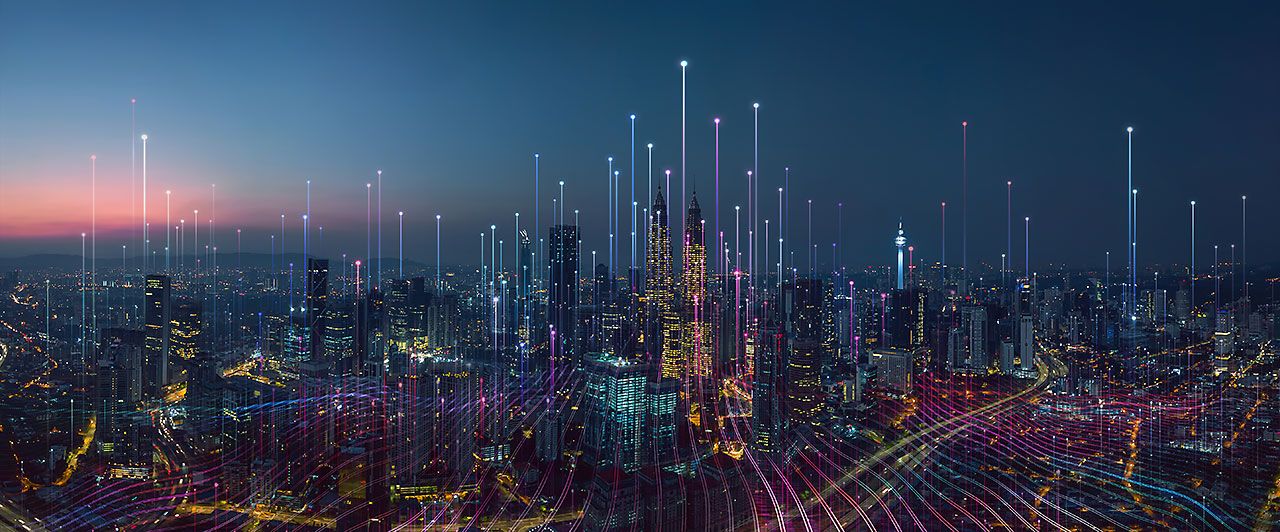What are smart cities? How are they helping during COVID-19?


Can smart-city technology actually come to our rescue during these challenging times. The simple answer is that they can! Around the world, in many countries, governments, policymakers and local authorities are turning to sensor-based IoT technology to trace infection spread, among other functions. In this article, we give you a brief rundown on what smart cities are, and why they are super relevant now during this global COVID-19 pandemic. In this article, we explore how COVID-19 is driving massive tech-adoption and how smart cities are helping us in our fight against this novel coronavirus!
The novel coronavirus outbreak that has stopped the entire globe in its tracks has also become a catalyst for innovation. The pandemic has pushed the adoption of technology in day to day life, like never before. Notwithstanding the tremendous amount of human suffering and economic ruin brought about by this pandemic, this is definitely a major silver lining.
COVID-19 driving evolution and tech-adoption
These unprecedented times are challenging establishment norms like never before. For years, there have been sensible voices clamouring for industries, organisations and institutions to fully embrace the information age and all the possibilities that it offers. And one might argue that we have, as a global unit, boldly stepped into the information age. However, not all sectors have been equal when it comes to modernising their habits and behaviours.
Let’s look at one example - universities. All over the world, there have been a number of distinguished voices speaking out against this age-old model of dispensing education. In fact, disgruntled millennial students have been expressing their ire and dissatisfaction, in no hushed voices, about the obsolete nature of most mainstream education systems and teaching modalities. Education as we traditionally knew it was never going to last very long. Dispensed through colleges and universities which (at least in places like the US) are getting uncomfortably pricey for most, this time consuming, human-resource-heavy system has been screaming for disruption. Moreover, with a huge number of young people making their living through the “gig-economy”, colleges and universities were left with no choice but to adapt to changing times. However much they tried, large organisations steeped in traditional mores don’t find it easy to make radical shifts to their ways of doing things. But, in the face of this global pandemic, they have been left with no other choice but to drastically embrace distance-learning protocols. Students all over the world are justified in wondering why this wasn’t the norm to begin with. After all, there seems to be parsimony and elegance to this scheme (at least when it works).
This is just an example to highlight how crisis can often drive rapid modernisation, streamlining and positive transformation. The same can be said about abandoning needless bureaucracy (across government and private sectors) and making organisations and institutions leaner and sharper in their focus.
In the past few years, we have made significant strides when it comes to our data-collecting and data-crunching capabilities. With the advent of technologies like energy harvesting and the resultant self-powered batteryless sensors that are now commercially viable at scale, IoT adoption has grown by leaps and bounds. And now, with this COVID-19 situation, this trend towards a sensor-based world is only going to intensify. And how!
It is precisely against this background that we would like to talk about smart cities and how they are especially important during COVID-19.
What are smart cities?

Let’s begin by defining what a smart city is - simply put, a smart city is an urban area that employs various kinds of IoT sensors to harness large amounts of varied data and then uses analytics to draw useful insights from the data. These insights are then used to create a feedback loop of optimisation and efficiency, across various aspects of urban planning and management.
Smart cities essentially work on an Information and Communication Technologies (ICT) framework, in order to develop more sustainable and efficacious urban solutions.
Smart cities allow for a seamless and elegant flow of information between an area’s citizens and it’s authorities. Smart cities, as they were conceptualised initially, were meant to provide citizens with a more hands-on stake in how their city carries out various aspects of its maintenance and functioning.
The areas of urban planning that could potentially come under the purview of a smart city are essentially endless - IoT sensors, as shown in many real-life cases across the world have been used in traffic control, waste management, power management, crime detection and mitigation, among others.
The basic schema is very simple - a cluster of sensors (potentially, of various types), strategically placed at various locations in the city, collect all types of data, which is then transmitted to a centralised server. Subsequently, this data is put through analytics technologies to draw pertinent insights, which ideally, are implemented, thereby completing the feedback loop.
What are the technologies and platforms involved?
An entire host of IoT and other cloud-based services form the backbone of most smart city projects across the world.
Technologies like smartphones, smart meters, sensor networks and RFIDs all find use in a typical smart city solution. Moreover, other specific solutions like smart cards, smart-bollards etc. are used in the implementing side of smart cities.
In the analytics wing of smart cities, technologies like big data, machine learning and artificial intelligence often find widespread application.
Here’s how smart cities make urban life better
What makes your smartphone a better, more functional tech-companion than, say, your landline from the 90s (in case you were around then)?
The answer quite simply lies in connectivity and data-capacity. Your smartphone can process orders of magnitude more data than even a PC from not so long ago. In addition to being nifty at collecting data, it also has top-notch connectivity that allows for quick and reliable transmission of this information in various ways. This increases the potential range of functions that your smartphone is good for, several times over.
The same holds true for smart cities. Let’s face it, urban living has never been known for its idyllic charm and healthfulness. All the way back from the times of Ancient Rome or Mesopotamia, living in cities has been associated with congestion, lack of hygiene, limited personal space and challenges with societal equality. Needless to say, the major cities of today’s world are not quite the cesspools of disease and death, like say even a wealthy European capital like London was, just 80 years ago! We have obviously come a long way, at least in the developed world, in making cities more livable and responsive to their citizen’s needs and preferences.
However, with our development, we have had to tackle a spate of new problems that didn’t exist before. Yes, we don’t have the problem of horse dung that New York City was blighted by, just a century ago; But, in its place, we have newer problems like air pollution, unhealthy noise levels and manic traffic congestion.

With smart cities, we can now efficiently and effectively work to monitor and maintain air quality, keep a check on crime levels and even use data to prevent those horrible traffic jams that no one loves. As a city dweller, smart cities open up numerous vistas for you to directly interact with the authorities that run your city. It gives you a direct say in making your gripes and suggestions known.
“This kind of a data-rich approach makes for urban spaces that are attractive, healthy, safe and highly livable.”
All you need is your smartphone, and you are now actively participating in pertinent matters such as how garbage is collected and disposed in your city, to reporting runaway crime incidents. Smartphones, it has to be said, represent just one of the ways in which citizens can engage with their city. In the near future, with concepts like connected cars and smart homes poised to become even more widespread, the cliched sky is actually the limit for smart city technology.
Why are smart cities going to be indispensable?
The last two decades have witnessed urbanisation like never before, especially in developing regions of the world such as Asia, South America and Africa. Over 54% of the global population, it is estimated, lives in cities. And this number is only increasing, with forecasts pointing to 66% of the human population being based in urban spaces by the year 2050.
To give additional perspective to these numbers, this means that over 2.5 billion people are set to move to cities, across the world, in the next three decades. While there is nothing to be said or done about people seeking economic opportunities in cities, we do need to be wary of environmental and social sustainability, as this shift towards urban living progresses.
Not to sound alarmist, but the clock is absolutely ticking on our civilisation. If anything, this coronavirus crisis has only highlighted several gross resource-misallocations and sub-par planning, all over the world.
The good news is that tech-driven innovation is keeping pace with newer challenges and continues to come up with innovative and sometimes, ludicrous solutions that would have sounded like first-rate woo, just a few years ago.
How big is this “smart cities” concept?
A report released by the British firm Arup in 2013 estimated a market opportunity of $400 billion, in the global smart cities space, by 2020.
If that sounds ambitious and hopeful, wrap your head around this - As early as 2019, the smart cities market, worldwide, was valued at USD 624 billion! And if that wasn’t whopping enough, the market is estimated to grow significantly to a value of USD 1712.83 billion by 2025.
You might be justified in taking these exact figures with a pinch of salt. But the point that is being put forth here is that smart cities are not to be ignored as a booming tech-trend, especially in the post-coronavirus era. Smart cities, no doubt, are going to be even hotter and more bullish in the AC age (i.e after coronavirus) compared to before.
COVID-19, an acid test for smart cities
"The current crisis is dramatic, but it can also be seen as a global testing laboratory. I remember a quote from Rahm Emanuel, the former Chicago mayor and chief of staff to President Barack Obama: 'Never allow a crisis to go to waste'.", quips Carlo Ratti, the director of the MIT Senseable City Lab.
Ritti goes on to add that we are now witnessing massive use of smart technologies, including smart city technology, to track people’s movements and health status in cities. Be it to track infected people or to ensure compliance with local social distancing regulations, there has definitely been an unmistakable acceleration, he says.
“Never allow a crisis to go to waste”
- Carlo Ratti, Director MIT Senseable City Lab
In the previous sections, we have explored how and why smart cities are just not a luxury, in this world of ours, with its challenges of overpopulation and urban sprawl. But now, during pandemic times, this imperative has to be exponentially overstated. Cities simply can’t afford to turn a blind eye to using data on a massive-scale in dealing with this pandemic. Not to take names or point fingers in such a time, but the example of South Florida is a grim reminder of how costly such oversights can be. This, of course, is a notable example from just a few weeks ago. Despite being alerted by private entities who had access to reliable data, not enough was done by the concerned authorities to dissuade people from coming in and congregating during spring break.
But on the flip side, there have been many success stories as well, where data capabilities (even if they weren’t super-accurate) have been harnessed effectively. Contact tracing apps from various sources have been deployed successfully in several countries, during the COVID-19 pandemic.
Smart cities against the coronavirus
One of the most heartening signs of our response to this pandemic has been the high levels of collaboration, across partisan lines. In a notable example of such an international, collaborative effort, the UN’s International Telecommunications Union (ITU) has announced that Valencia, Spain will lead an international task force aimed at sharing ingenious solutions and circulating proven best-practices in cities around the world.
Ernesto Faubel, a high-ranking analyst from the ICT, based in Valencia says “the main objective of this initiative, titled “Emergency response of COVID-19 cities”, is to track the progression and evolution of the contagion and analyse signs that could help forecast and anticipate citizen behaviour, thus slowing down the spread of the virus. We will provide a worldwide platform for data-sharing and develop a policy framework for smart management of public health crises in urban areas”.
Valencia has designed a big data project wherein they are able to analyse aggregated and de-identified data from telecommunication companies and identify patterns with respect to people’s mobility and the impact they could have on the spread of the virus. They are also working on developing AI tools that could predict citizen’s movement patterns and thereby, isolate locations which are likely to be convergence-points for large numbers of people.
Faubel adds, “ With all this, we will be able to design dashboards with estimations about citizen mobility and build epidemiological models of the virus."
Among the several initiatives that this Valencia based task force has implemented during the COVID pandemic, one that stands out is an internet portal that offers a live-evolution map of the epidemic. The portal also provides resources to assist people in need, during times of emergency.
Balancing caution with economic sense
Obviously there is not much that can be said against the validity of countries and cities opting for a complete lockdown. After all, total lockdown is the logical first solution against an aggressive pandemic like COVID-19. However, it doesn’t need to be mentioned just how catastrophic such measures can be, from a socio-economic standpoint.
Many countries in the world have opted instead for smarter, more selective containment solutions. South Korea is a notable example of a country that opted against a radical social policy, in the face of rising coronavirus cases.
Although South Korea carried out large-scale testing, even on asymptomatic individuals and was strict in isolating infected people and quarantining their contacts, it never took the step of complete closure of all businesses and institutions. This means that, although there were some economic losses, they haven’t been as significant or debilitating as the recession that some prominent economic heavyweights are looking at in the not too distant future.
It is not for laypeople to debate on whether or not such measures would work in other places. However, there is definitely evidence to suggest that IoT based smart-city technology has a huge role to play in containing and possibly vanquishing this obstinate coronavirus.













